Now that I have finished my SP10 turntable project, I want to build a high end phono stage to meet and exceed it. There is a well reviewed phono stage that has the following published details.
No caps or resistors in the signal path
Point to point
Pair C3g tubes in input stage, 2123 Hz, passive regulated DC heaters
Pair C3g tubes in the output stage, 50-500 Hz, AC heaters
LCR network transformer driven
39 db output level for MM
Step-up transformer for MC
Power supply 6CA4/EZ81 tube rectifier w/choke filter
Input impedance 47Kohm/200 pf
Output impedance 1200 Ohm
Gain 39 db
I found these transformers that have similar construction to the commercial unit. Noguchi Tranformers FMQL and FMQH RIAA equalizer coils.
Are there any known schematics that can be modified or anyone up to the task to sketch out? Or too difficult a task?
No caps or resistors in the signal path
Point to point
Pair C3g tubes in input stage, 2123 Hz, passive regulated DC heaters
Pair C3g tubes in the output stage, 50-500 Hz, AC heaters
LCR network transformer driven
39 db output level for MM
Step-up transformer for MC
Power supply 6CA4/EZ81 tube rectifier w/choke filter
Input impedance 47Kohm/200 pf
Output impedance 1200 Ohm
Gain 39 db
I found these transformers that have similar construction to the commercial unit. Noguchi Tranformers FMQL and FMQH RIAA equalizer coils.
Are there any known schematics that can be modified or anyone up to the task to sketch out? Or too difficult a task?
I have spent quite a few hours searching for a schematic that is close to the outline in my first post, to no avail.
I did find this phono pre that has a very minimal part count, makes use of quality transformers, chokes and C3g tubes in two stages. My searching did not discover anyone that has built it.
I wrote the designer but he is not interested in implementing LCR.
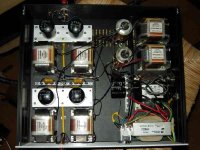
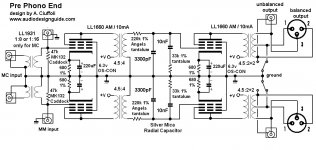
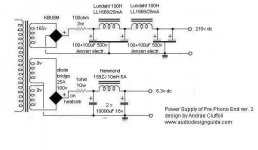
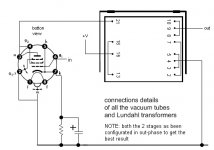
Sent from my iPad using Tapatalk
I did find this phono pre that has a very minimal part count, makes use of quality transformers, chokes and C3g tubes in two stages. My searching did not discover anyone that has built it.
I wrote the designer but he is not interested in implementing LCR.




Sent from my iPad using Tapatalk
Hi Coasttoast, something I keep in mind is the "acoustic dimension" proposoal. They offer transformers for around 500USD a pair. But their schematic includes caps.
Acoustic-Dimension, high-end audio and components for tube audio (Look for transformers and LCR).
Question is if a LCR generally brings improvements even if the stage includes a cap. So a LCR could be purchased anyway for a project. Trying is everything. What kind of feedback have you received from other DIY'ers or friends owning one? How good is a LCR compared with ultra high end phono stages like Pass Xono or Audio Note? This question keeps spinning in my head.
CAPS: My feeling tells me that a stage without cap may not be the very last word just because all matters were going to avoid the cap - sometimes on costs of other points.
Of course if a phono stage works well in matters of design - a cap less design has to be superior I agree.
PS: Coasttoast, ever compared your SP10 to other high end drives? I'm really think how much money I should spend for a perfect bearing of my mass drive + a high end motor unit with intelligent motor controlling...Sometimes I think a SP10 is cheaper.
Sorry I cannot help much in your thread.
Regards
Acoustic-Dimension, high-end audio and components for tube audio (Look for transformers and LCR).
Question is if a LCR generally brings improvements even if the stage includes a cap. So a LCR could be purchased anyway for a project. Trying is everything. What kind of feedback have you received from other DIY'ers or friends owning one? How good is a LCR compared with ultra high end phono stages like Pass Xono or Audio Note? This question keeps spinning in my head.
CAPS: My feeling tells me that a stage without cap may not be the very last word just because all matters were going to avoid the cap - sometimes on costs of other points.
Of course if a phono stage works well in matters of design - a cap less design has to be superior I agree.
PS: Coasttoast, ever compared your SP10 to other high end drives? I'm really think how much money I should spend for a perfect bearing of my mass drive + a high end motor unit with intelligent motor controlling...Sometimes I think a SP10 is cheaper.
Sorry I cannot help much in your thread.
Regards
McLanz, yes Acoustic Dimenson is where I found the Noguchi Transformers. They have 3 or 4 brands of LCR transfomers. But only the "Tango" and "Nasu" style schematic posted.Hi Coasttoast, something I keep in mind is the "acoustic dimension" proposoal. They offer transformers for around 500USD a pair. But their schematic includes caps.
Acoustic-Dimension, high-end audio and components for tube audio (Look for transformers and LCR).
Question is if a LCR generally brings improvements even if the stage includes a cap. So a LCR could be purchased anyway for a project. Trying is everything. What kind of feedback have you received from other DIY'ers or friends owning one? How good is a LCR compared with ultra high end phono stages like Pass Xono or Audio Note? This question keeps spinning in my head.
CAPS: My feeling tells me that a stage without cap may not be the very last word just because all matters were going to avoid the cap - sometimes on costs of other points.
Of course if a phono stage works well in matters of design - a cap less design has to be superior I agree.
PS: Coasttoast, ever compared your SP10 to other high end drives? I'm really think how much money I should spend for a perfect bearing of my mass drive + a high end motor unit with intelligent motor controlling...Sometimes I think a SP10 is cheaper.
Sorry I cannot help much in your thread.
Regards
It seems there is a divide between the use transformers in place of capacitors. I guess each has its place (FYI, I have no hands on knowledge of electrical design, I picked up my first soldering iron less than 3 years ago!) but my practical side side tells me that the basic design of a cap is to store and release energy, then it's use at the very beginning of the electrical signal from the cartridge has to smear the sound some, and then get amplified several more times.
Also, this SP-10 is my first Turntable. I have not done any comparisons. I have not yet mounted my Koetsu yet, so still at the beginning of my vinyl journey.
Searching again today I found a schematic in the right direction. Steve Bench. On Jacmusic.
Lundahl Moving Coil transformers.
Here is the schematic
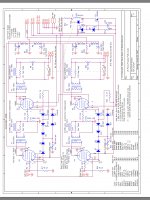
Has anyone built this?
Lundahl Moving Coil transformers.
Here is the schematic

Has anyone built this?
Here is the power supply for the Steve Bench (now Stephie Bench) phono stage. The phono stage is actually an LR design.
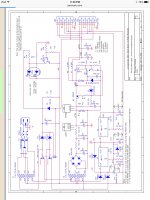
After some more digging I have been told a couple of people have built this design and had "problems stabilizing it in the bass, presumably because of that positive feedback fix for the bass roll-off". I also understand that they were not able to overcome it.
I'm still researching to see if there is a solution or an update to the design.

After some more digging I have been told a couple of people have built this design and had "problems stabilizing it in the bass, presumably because of that positive feedback fix for the bass roll-off". I also understand that they were not able to overcome it.
I'm still researching to see if there is a solution or an update to the design.
I'm puzzled. If you arrange ordinary electronic components in order of nearness to ideal behaviour then resistors come first, then capacitors and finally inductors and transfomers come way behind. On what basis could someone then choose to avoid the most ideal components and deliberately use the least ideal components?
I'm not being funny; I am genuinely puzzled.
PS I know why early valve electronics (1920s) used transformers and chokes for coupling: they had very low mu valves so needed the extra voltage gain from a transformer, and resistor and cap technology was quite crude back then. Today things are different.
I'm not being funny; I am genuinely puzzled.
PS I know why early valve electronics (1920s) used transformers and chokes for coupling: they had very low mu valves so needed the extra voltage gain from a transformer, and resistor and cap technology was quite crude back then. Today things are different.
Do you know Dave Slagle?
:: View Forum - Phono
Thomas Mayer (vinylsavor) use Dave's coils such topology.
VinylSavor: Making of a D3a LCR RIAA Phono Preamp - Part 1
:: View Forum - Phono
Thomas Mayer (vinylsavor) use Dave's coils such topology.
VinylSavor: Making of a D3a LCR RIAA Phono Preamp - Part 1
I'm puzzled. If you arrange ordinary electronic components in order of nearness to ideal behaviour then resistors come first, then capacitors and finally inductors and transfomers come way behind. On what basis could someone then choose to avoid the most ideal components and deliberately use the least ideal components?
I'm not being funny; I am genuinely puzzled.
PS I know why early valve electronics (1920s) used transformers and chokes for coupling: they had very low mu valves so needed the extra voltage gain from a transformer, and resistor and cap technology was quite crude back then. Today things are different.
Since I'm new to electronics and have no design experience, I have no preconceived thoughts on parts selection or preference to topology choice.
My choice in looking at building an LCR or LR phono stage is based on reviews of commercial equipment using this topology and from the recommendation by a personal friend who's ears I trust more.
One such commercially available product is the Yipislon.
As far as the "order of nearness to ideal behavior" goes, think about this. My Koetsu Urushi Black (yet to be mounted) is the basis of the beginning of the audio electronic trail. What is the actual stylus connected to? A resistor? A capacitor? A transformer! The next step in the electronic trail, since this is a MC cart is a step-up resistor? A step-up capacitor? A step-up transformer! (Well at least in what most consider high-end products)
At least this is some of the information I've read on my audio journey so far.
An MC step-up transformer is an appropriate technology for the technical requirement. There are alternative technologies, such as very low noise solid-state circuitry. Hence one can make a valid choice between competing options. However, it must be understood that the transformer is not there because having a transformer is a good thing in itself but because a transformer, in spite of its limitations, can do the required job without damaging the sound too much.
A good rule to follow in electronics is "avoid wound components, unless you really need them". An ideal CR network has exactly the same response as an ideal LR network but almost any real CR network will have wider bandwidth, less distortion and less interference pickup than a real LR network with the same response. Hence my puzzlement.
A good rule to follow in electronics is "avoid wound components, unless you really need them". An ideal CR network has exactly the same response as an ideal LR network but almost any real CR network will have wider bandwidth, less distortion and less interference pickup than a real LR network with the same response. Hence my puzzlement.
Hi,
am puzzled too.
While Caps seem to have a rather negative image, inductors seem to be regarded as good things.
Just doing the opposite of what a cap does, doesn´t make an inductor a better and superior device in any way.
Instead the drawbacks DF96 mentioned apply and the parasitics are more pronounced/effective.
I can´t see a reason for a view like this:
It seems somehow anti-logic, doesn´t it?
jauu
Calvin
am puzzled too.

While Caps seem to have a rather negative image, inductors seem to be regarded as good things.
Just doing the opposite of what a cap does, doesn´t make an inductor a better and superior device in any way.
Instead the drawbacks DF96 mentioned apply and the parasitics are more pronounced/effective.
I can´t see a reason for a view like this:
If I replaced a non-ideal device by either a more-non-ideal device or a circuit emulating the device under useage of a couple of more-non-ideal devices, I wouldn´t expect a superior outcome.Of course if a phono stage works well in matters of design - a cap less design has to be superior I agree.
It seems somehow anti-logic, doesn´t it?

jauu
Calvin
.... MC step-up transformer....
A good rule to follow in electronics is "avoid wound components, unless you really need them". An ideal CR network has exactly the same response as an ideal LR network but almost any real CR network will have wider bandwidth, less distortion and less interference pickup than a real LR network with the same response. Hence my puzzlement.
Hi DF.
In your statement I can confirm my tech experiences:
RIAA concept "RLC" or "RC"; RC is (very) more detailed (subtile)
AMP with "output transformer" (& interstage) or "OTL"; OTL more detailed ... better response (high & low) etc ...
Let's play music ...
Karel
Sorry, only just spotted this earlier comment.Coasttocoast said:It seems there is a divide between the use transformers in place of capacitors. I guess each has its place (FYI, I have no hands on knowledge of electrical design, I picked up my first soldering iron less than 3 years ago!) but my practical side side tells me that the basic design of a cap is to store and release energy, then it's use at the very beginning of the electrical signal from the cartridge has to smear the sound some, and then get amplified several more times.
Would you be interested to hear that an inductor works via energy storage too? Capacitors store energy in an electric field. Inductors store energy in a magnetic field. A difference is that real capacitors keep almost all of the field within them, while real inductors can lose some of it - which is why inductors create and pick up more interference than caps. Most capacitor dielectrics are more linear than inductor cores, so most caps create less distortion than most inductors. At audio frequencies the stray inductance of capacitors can be largely ignored, while the stray capacitance of inductors is a major consideration - resonances just above the audio band can affect phase response within the audio band. Similarly for resistance: minor issue for caps; major issue for inductors.
Caps do not smear the sound. Even if they did, the sound you hear has come through dozens of caps in the studio so a few more in the home could do little more damage.
@DF96: There's no rational argument for using poorer-performing and fantastically more expensive components; but don't underestimate the entertainment value in doing things in an unconventional way. If you try to find logic in the common fashionable idea of avoiding magnetic leads in components, then feeding a coil wound around a hunk of iron, you will not succeed.
Get past the engineering approach- this is being done for emotional reasons (e.g., fun and the feeling of creativity that comes with doing something "different"), and there's nothing wrong with that. After all, you DO use a tube power amp, right?
Get past the engineering approach- this is being done for emotional reasons (e.g., fun and the feeling of creativity that comes with doing something "different"), and there's nothing wrong with that. After all, you DO use a tube power amp, right?
Oops! I had forgotten that magnetic component leads are A Bad Thing. Maybe there are good and bad magnetisms? Yes, I do use a valve amp - but not for 'tube sound'.
Anyway, I will continue to be patient. Surely someone can come up with something more solid than "LCR RIAA networks must be good because some people tell me they are good"?
Anyway, I will continue to be patient. Surely someone can come up with something more solid than "LCR RIAA networks must be good because some people tell me they are good"?
It would be an interesting design to eliminate all resistors, by using choke load and make use of the internal resistance of the tube stage. Capacitors could also be eliminated by transformer coupling as in the cited examples. Then we would use only lossless passive components that do not contribute to noise. Perhaps they have different sonic character than resistors, that have their own character, too.
The internal resistance of a valve is non-linear and noisy. Transformers are not lossless. so they do contribute some noise (unlike caps, which are almost lossless at audio frequencies). They certainly have a "sonic character", far more so than resistors - I suspect it is this which attracts some people, being another example of 'my preferred distortion is more accurate than your lack of distortion'.
A phono preamp with no resistors would change its RIAA characteristic as the valves aged. At least this would provide lots of scope for tube rolling, and spurious claims that this tube is superior to that tube when all that is happening is that people are implementing tone controls via tube swapping rather than knob twiddling.
A phono preamp with no resistors would change its RIAA characteristic as the valves aged. At least this would provide lots of scope for tube rolling, and spurious claims that this tube is superior to that tube when all that is happening is that people are implementing tone controls via tube swapping rather than knob twiddling.
Thanks all for your comments about phono stage topology.
However...........I started this thread with this purpose, Re: 2 stage Passive LCR RIAA,
"Are there any known schematics that can be modified or anyone up to the task to sketch out? Or too difficult a task?"
Somehow phono stages, such as have been previously mentioned, have become "the best I ever heard" by reviewers and audiophiles without using capacitors and resistors in the signal path.
However...........I started this thread with this purpose, Re: 2 stage Passive LCR RIAA,
"Are there any known schematics that can be modified or anyone up to the task to sketch out? Or too difficult a task?"
Somehow phono stages, such as have been previously mentioned, have become "the best I ever heard" by reviewers and audiophiles without using capacitors and resistors in the signal path.
- Status
- This old topic is closed. If you want to reopen this topic, contact a moderator using the "Report Post" button.
- Home
- Source & Line
- Analogue Source
- 2 stage Passive LCR RIAA
